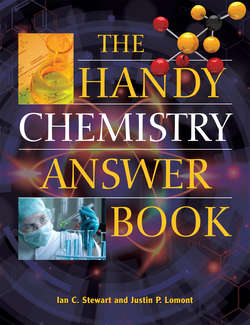Читать книгу The Handy Chemistry Answer Book - Justin P. Lomont - Страница 29
На сайте Литреса книга снята с продажи.
What causes lightning?
ОглавлениеDuring a storm, collisions of water and ice particles in the clouds can result in a charge separation within the clouds, resulting in the buildup of significant electric fields. If the fields become large enough, lightning may occur between the cloud(s) and the ground, or between different clouds, which reduces the charge separation. The lightning in the sky is just a very large spark, not all that different from how you might occasionally get a small shock from static electricity when you touch a doorknob.
How can light be used to initiate a chemical reaction?
When light strikes a molecule, it has the potential to excite an electron to a higher energy level. When this happens, the molecule becomes less stable and more reactive. This can even cause the molecule to fragment, generating a more reactive species or catalyst, which can then go on to react with another molecule.
What is diffusion?
Diffusion is essentially the random motion of molecules (or atoms) through a medium. It causes the concentrations of species in a liquid or gas to even out across the accessible volume. Diffusive motions of molecules in a liquid or gas are typically responsible for the chance encounters that lead to bimolecular reactions.
Can reactions take place in gas, liquid, and solid phases?
Absolutely. Bimolecular (two species) reactions taking place in the gas phase and in solutions are quite similar in that they involve random diffusion of reactant molecules until they collide, at which point a reaction may take place. For reactions involving solids, the surface of a solid is often reacting with another species that is present at the interface between the solid and a gas or liquid with which it is in contact. An example would be your car rusting to form oxides.
What is the partial pressure of a species in a gas?
If you have a rigid container containing a mixture of gases, the partial pressure of a species is simply the pressure the gas would have if that one species occupied the entire volume of the container.
How does pressure affect the rate of a chemical reaction in the gas phase?
In a gas phase chemical reaction, the pressure (or partial pressure) of a chemical species is directly related to its concentration. In just the same way we could write rate equations for solution phase reactions involving a constant multiplied by the concentrations of species, we can write rate equations for gas phase reactions that involve a constant multiplied by the partial pressures of species in the gas phase. So just like in a solution phase reaction, increasing the pressure of a reactant in the gas phase will increase the rate at which products are formed.
What is an electron transfer reaction?
It’s just what it sounds like: a reaction that involves movement of an electron from one species to another. This most often means the electron is moving between two different molecules, although intramolecular (one molecule) electron transfer reactions are also encountered commonly in the study of chemistry.
Does reaction stoichiometry also apply to electron transfers?
Yes, for just the same reasons it applies to chemical reactions. The conservation of matter tells us that we must have the same amount of stuff before and after a reaction has taken place, so the number of electrons on each side of a chemical reaction equation need to be balanced for the equation to be accurate.
Where are electron transfer reactions important?
Electron transfer reactions are important in many areas. In biological systems, processes like photosynthesis, nitrogen fixation, and aerobic respiration (the process your body uses to make energy using oxygen) all rely heavily on electron transfer reactions. Electron transfer reactions are also frequently used to obtain pure metals from ore. Electrochemical cells (see “Analytical Chemistry”) also rely on electron transfer reactions; the batteries that power your cellular phone and other devices use electron transfer reactions to do so.
What is a pyrophoric reagent?
Pyrophoric reagents are substances that will ignite spontaneously when exposed to air. Very often, this is due to a reaction with the water in the air. Thus pyrophoric reagents should be used only under inert atmospheres, such as in a glovebox filled with an inert gas such as argon or nitrogen. Often, pyrophorics will be sold as solutions already dissolved in a solvent so that they do not tend to create fires so easily. Some of the more mild pyrophoric substances can be handled in the air, but caution needs to be exercised to flush air out of the container before storing them for an extended period of time. They also must be disposed of with caution, or they might accidentally set the wastebucket on fire!
Perhaps not surprisingly, pyrophoric materials can be useful for starting fires in a controlled manner. Pyrophoric materials are present in the spark-generating mechanisms in lighters and some firearms.
What is the flash point of a substance?
The flash point of a substance is the temperature above which it can form an ignitable vapor in the air. This requires an ignition source—the vapor may no longer burn if a source of ignition is not present.
What is the autoignition temperature of a substance?
The autoignition temperature is similar to the flash point, except that it does not require an ignition source to begin or to continue burning. Above the autoignition temperature, the vapor will start to burn, and continue to burn, even in the absence of any ignition source.
